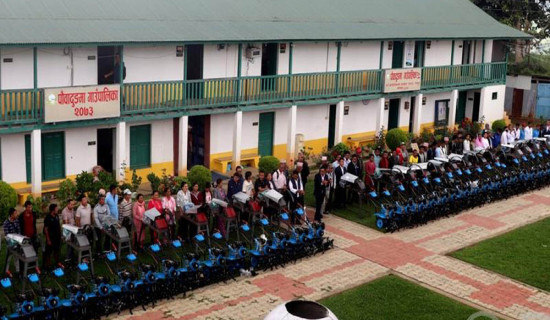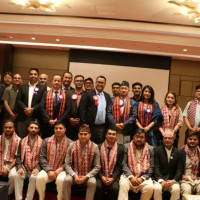- Wednesday, 2 July 2025
Manang’s culture faces climate change effects
By Yadu Prasad Bhatta,Manang, Aug. 28: The development of road networks and modernisation is causing the traditional culture and civilisation of Manang to fade away.
The expansion of roads up to the foothills of the Himalayas has contributed to the loss of old customs and traditions. While the expansion of road networks attracts tourists, it also promotes the growth of the hotel business.
Until about five years ago, houses made of mud and wood were common in the area. However, old houses are now gradually disappearing.
According to locals, when constructing the houses, the beams of the houses were used to reinforce with yak or cow horns for strength.
Remembering the past, 81-year-old Yangdung Gurung from Pisang, Ngisyang Rural Municipality-1 in Manang, said, “Previously, houses were built by placing pine planks and covering them with mud. Straight pine planks were used, but now it has now hard to even see them.” He added that concrete houses are necessary for the convenience of tourists.
Tourists do not prefer to stay in old, dark, and narrow houses. Even for the sake of tourists, it has become a necessity for the people of Manang to demolish old houses and build new concrete ones.
Gurung said that the practice of going to the forest, cutting pine trees, and making planks to build houses is fading away. “Even if we build a house with corrugated sheets, it leaks water. The house is also cold, and when it snows, it gets even colder. Houses made of mud and pine wood used to be warm and safe, but things have changed now. The appearance of the place has also started to change,” he said.
In Manang, where it used to rarely rain, now it has started to rain. It is not suitable to live in houses made only of wood and mud. “Previously, we only knew about rain in lower Manang. Now, it rains in upper Manang as well,” he said.
Old houses need to be preserved. However, locals believe that with climate change, rainfall has started in Manang. Binod Gurung, president of the Tourism Business Association Manang, stressed the need to preserve the old houses in the area from a tourism perspective, stating that due to rain in places where it never used to rain, they have been forced to demolish old mud and wood houses for safety.
He also said that last year, there was human loss when mud and wood houses collapsed due to rainfall.
Rinjen Darje Gurung, the former chairman of Ngisyang Rural Municipality-9 in Manang, said that clustered houses were a favorite among tourists. He said that the environment is changing due to climatic suitability and that Manang’s old houses, which existed as part of its identity, are now on the verge of being lost.
He said, “Tourists used to come to see the beams of the houses tied with yak horns. Now such houses are gradually becoming scarce.”
Gandaki Provincial Assembly member Munindrajung Gurung mentioned that being a tourist place, the construction of houses should focus on preserving the old structures.
Konzho Tenjing Lama, chairman of Narpa Rural Municipality, said that they have been forced to build houses using corrugated sheets in places where motorable roads have not yet reached.
He said, “The snow used to settle on the roofs of mud and wood houses, and people used to live by clearing the snow. Now, with increased rainfall, the use of tin and cement has increased in Nar village.”
Although the construction of tin and wooden houses is gradually disappearing in Nar village, there are still old houses in Phu village. However, with the increasing rainfall, the risk is also growing.
In Tachai village, Ward No. 8 of Naso Rural Municipality, old houses are gradually being demolished. The appearance of houses at the entrance to Manang is changing.
Former chairman of Naso-8, Hupa Jung Gurung, said that due to the need for safe living, they have been compelled to use tin when building houses. He said that being a tourist area, there has been a request to build houses that appear to maintain the same appearance.
The traditional appearance of villages such as Tachai, Tilche, Thonche, Danakyu, Odar Gaun, Thanchok, Upper Manang, Pisang, Humde, Nar, Phu, Manang village, and Khangsar is gradually changing with the construction of modern houses.
















